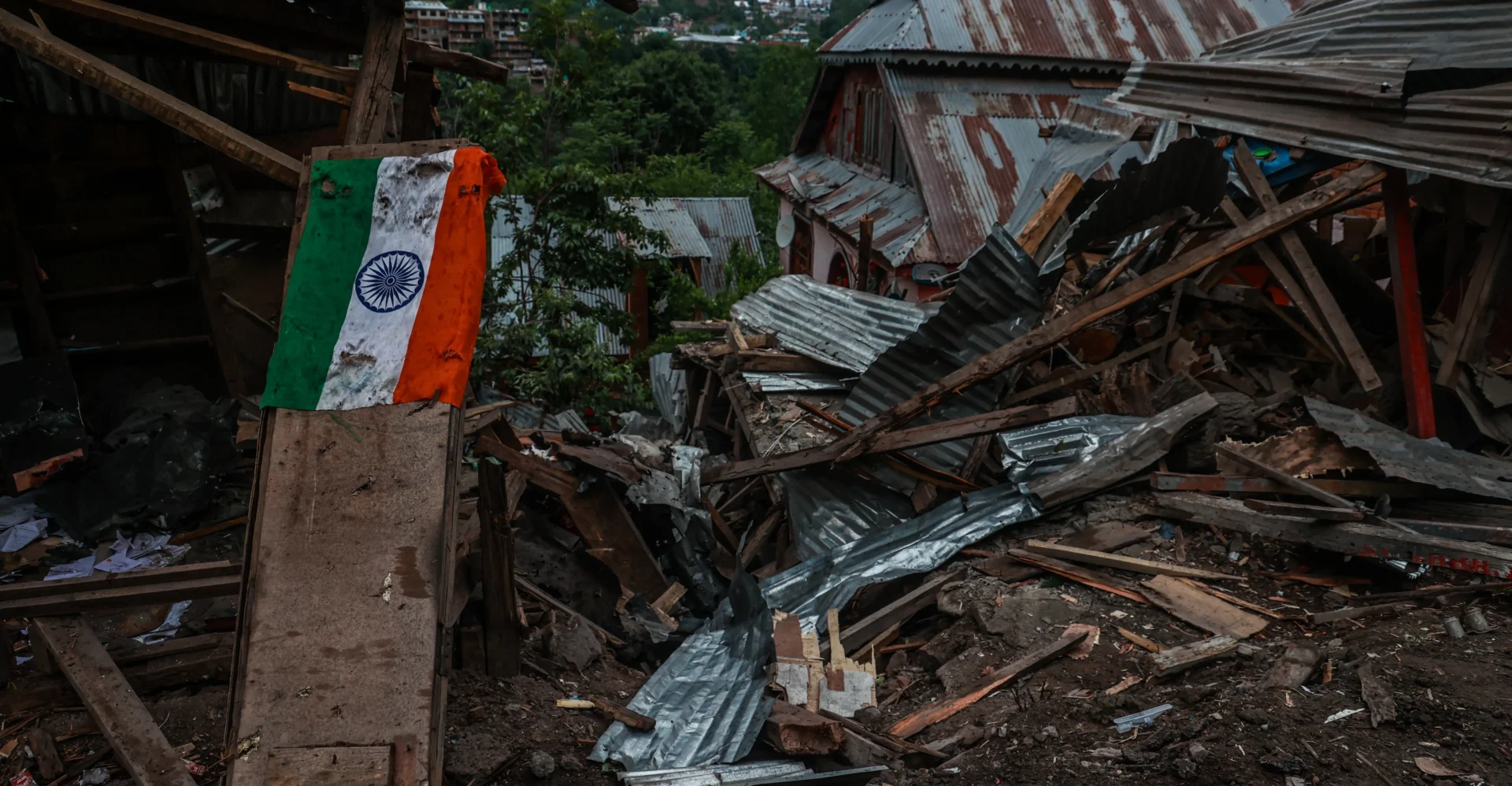The Bharatiya Janata Party (BJP), ruling party in India, is a political offshoot of Rashtriya Swayamsevak Sangh (RSS). RSS and the current Indian ruling elite share a profound love for the Zionists in Israel and condone their transgressions in the occupied Palestinian lands. The relations between India and Israel have grown significantly since Modi took power in 2013. Especially, the defense cooperation between India and Israel has grown multifold.
India wants to replicate the Israeli escalation dominance model vis-à-vis Pakistan, which is evident from their offensive military posturing and episodes of Balakot strikes in 2019 and recent attacks after the Pahalgam incident. India’s utilization of Israeli technology, especially Harop drones in its latest attacks on Pakistani air defenses and imitation of layered air defense like Israel employs, as well as Israel’s cooperation in an advisory role, symbolize ideological as well as an attempt at operational imitation.
The incumbent leadership of India draws a parallel with Zionists and takes inspiration from them. The ministers belonging to the BJP have openly called for replicating the Israeli model in occupied Jammu and Kashmir and against Pakistan. Israel has achieved escalation dominance over its neighbors because it has the unconditional support of the United States, possesses advanced military technology vis-à-vis its neighbors, and is a nuclear power.
Read More: Top Indian Defense Official Admits Loss of Jets in Clash with Pakistan
This Indian approach is highly dangerous and a recipe for disaster due to underlying factors of critical importance.
Geostrategic Constraints
Israel’s escalation dominance over its regional adversaries, which include Arab states and a plethora of non-state actors, stems from technical superiority and receiving staggering kinetic as well as logistical support from Western countries, chief among which is the United States. India, too, with its closeness to the USA via QUAD, miscalculated that it too would be able to pull off what Israel does without impunity.
But Indo-US congruence has some complexities. USA’s relation with Pakistan, especially in the defense realm, has endured for decades. So, India’s thought of overpowering Pakistan whilst the US and other Western powers remain indifferent is not possible. Israel receives unconditional ‘great power’ support from the US, which helps it in establishing escalation dominance.
USA’s military and naval assets in the Middle East directly partake in the defense of Israel, be it using interceptor missiles to augment Israeli air defense, or threatening Iran by US presence in the region, or rapid logistical support for the Israeli war effort. Such is not the case with India. While both are close in defense cooperation, platform linearity, interoperability, and strategic compulsion are absent.
Whereas Pakistan has close ties with China, its all-weather ally, that has not only assisted in achieving a technological edge (as evident in recent engagement where Chinese fighter jets and air defense were Pakistan’s mainstay weapons against India) but also ensures a secure supply chain in times of peace and conflict. In addition, China and Pakistan are congruent on mutual security and geopolitical threats from India.
Technological Limitations
Coming to escalation dominance and its technical vernacular, even Israel was not able to completely establish itself and meet its limits. This was evident in Iran’s True Promise 1 and 2 Operations, where Iranian projectiles eventually overcame Israeli and US layered defenses and struck their airbases. Despite clandestine covert operations and threats of all-out strikes, the US and Israel have not been able to establish complete dominance on the axis of resistance.
India looks forward to doing the same to Pakistan; it will be a different ballgame altogether. The country is rapidly modernizing its military arsenal and might acquire a fifth-generation fighter jet, J-35, from China, well before India. Also, it is worth noting that aerial superiority in numbers is pivotal for escalation dominance. India is facing a shortage of 12 squadrons with no feasible solutions yet on the horizon.
Battle tactics, signals intelligence, and technological superiority all work in tandem to establish escalation dominance. Pakistan has state-of-the-art F-16s, JF-17s, AEWACS, and Electronic warfare aircraft, the latest J-10C armed with PL-15 long-range missiles and a vast arsenal of tactical and strategic weapons, which the country would employ as per its escalation appetite.
Read More: Terrorism and the Ballot: How Modi’s BJP Turns Tragedy Into Triumph
The doctrinal underpinning of using Israeli weapons, realistically speaking, was lacking in India in this round of conflict. Israeli Harop Drone, while a Kamikaze drone, specializes in targeting enemy air defense and radars due to sensors that detect radar signals and hunt them down.
The Harop has been used in Syria by Israel in SEAD (Suppression of enemy air defense operations) effectively. India attempted to use these to desirable effect, yet fell short because Pakistan had vast experience in utilizing drones from Turkey, China, and its domestic defense production. Hence, Pakistani air defense tactfully protected its assets in the recent engagement.
Near Parity in Conventional Forces
Pakistan and India have near-conventional parity in almost all military domains. India has an edge over Pakistan in terms of numbers and military spending, but India has to take care of the Chinese threat simultaneously. India has unresolved border disputes with China, due to which it fought a war in 1962.
The skirmishes and standoffs between India and China have increased due to India becoming a partner of the US in the Asia Pacific as part of its strategy of containing China. Chinese military spending is three times that of India. India’s warfighting doctrine demands capacity building, operational preparedness, and military modernization for two fronts.
The current Indian regime continues to test the waters with Pakistan but has failed to establish its regional dominance in South Asia. The failed Balakot airstrikes in 2019 ended with India losing multiple fighter aircraft in a dogfight with Pakistan’s air force, and one of its pilots was captured by Pakistan.
Read More: Pakistan vs India: Hard Times Make Hardy Hearts
Pakistan retaliated with Operation Swift Retort, and PAF jets went inside Indian occupied Jammu and Kashmir and conducted strikes near counter-force targets, showing resolve and capability. The recent military exchanges between Pakistan and India after the Pahalgam incident were also an effort by India to carve out space for a limited war and achieve escalation dominance vis-à-vis Pakistan.
India launched Operation Sindoor and targeted multiple Pakistani cities with Brahmos cruise missiles and Israeli-origin drones such as Harop. Pakistan responded with Operation “Bunyan–al–Marsus” and PAF shot down six Indian aircraft, including a French-origin Rafael and a Russian-origin Sukhoi 30-MKI. PAF shot down these jets using Chinese-made J-10 Cs and JF-17 Thunder multirole aircraft.
Along with Air Force assets, the Pakistan army employed Fatah-I and II medium-range rockets against India. The conflict remained well below the nuclear threshold, and Pakistan only utilized conventional armaments of a low level to respond to the Indian attack.
The Equation of Strategic Weapons
Pakistan and India both are nuclear weapon states, which creates deterrence between adversaries due to their lethality and destructive power. India’s pursuit of nuclear weapons was prestige-driven, while Pakistan developed its nuclear weapons due to the Indian threat. The presence of nuclear weapons has maintained stability at the larger level between India and Pakistan. The Indian Cold Start Doctrine (CSD) suggests swift military ingress into Pakistan through Integrated Battle Groups(IBGs).
This offensive war-fighting Indian doctrine is aimed at carving out space for a limited war under a nuclear overhang. Pakistan proposes a Full Spectrum Deterrence (FSD) against India’s aggressive military designs. FSD aims to counter India’s offensive military posturing by developing appropriate counter-technologies.
This approach does not seek parity but aims to implement essential measures to prevent India from attaining escalation dominance. For instance, the Kargil conflict of 1999 between India and Pakistan remained limited to the disputed region of Jammu and Kashmir and didn’t turn into a full-scale war. Indian Prime Minister Atal Bihari Vajpayee’s statements are on record with the air force chief, stating that you should not cross the Line of Control (LOC).
Read More: The Peril of Assumptions in the India-Pakistan Conflict
The former Indian Air Chief Anil Tipnis recalled from his Kargil memory that he wanted to know from General Malik whether the ground forces could do the job without utilizing the air force. “Even before Ved Malik could respond, I chipped in, saying that we are ready if the Army needs it.
The Prime Minister was pensive momentarily and then said ‘kal subah shuruwat kariyega (begin tomorrow morning) ‘ in a voice firmer than I had ever heard… (Vajpayee said) ‘No, we will not cross the Line of Control, ‘Tipnis said. Vajpayee’s reluctance to escalate stemmed from the fear of nuclear exchange, and the conflict remained confined to the disputed region.
The presence of nuclear weapons is a hindrance to India’s offensive doctrinal posturing and achieving escalation dominance vis-à-vis Pakistan.
Bottom Line
The issue remains that despite India’s setback in its foray against Pakistan, Delhi still seems adamant to realize that it cannot establish dominance or overpower Pakistan, a Pakistan that not only wields conventional arms but also a credible nuclear deterrent.
The Hindu right’s ideological fetish with Zionism fuddles strategic purview, especially in a high-stakes environment like South Asia and a peer competitor like Pakistan, which itself has had a siege anxiety from India for the last seven decades and has always strived to keep parity in terms of deterrence.
But right-wingers running security policy in India thrive on communal politics against Muslims. Their paranoia will increase even more after their recent not-so-successful strikes.
*The views expressed in this article are the author’s own and do not necessarily reflect the editorial policy of TDI

Syed Raza Abbas
Syed Raza Abbas is a Research Associate at SVI, Islamabad. He focuses on arms control, nonproliferation, and Strategic Stability, with a particular emphasis on the Middle East.

Hammad Waleed
Hammad Waleed is a Research Associate at SVI, Islamabad. He focuses on Emerging Technologies and South Asian Security.



